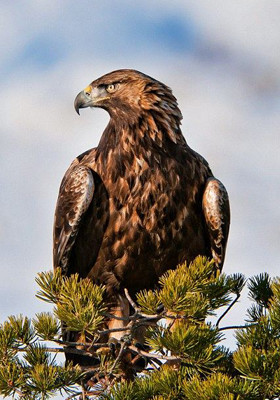Golden Eagle (Aquila Chrysaetos)

| Order: | Accipitriforme |
| Family: | Accipitridae |
| Subfamily: | Buteoninae |
| Genus: | Aquila |
| Type: | Golden Eagle |
STATUS:
ATTENTION! THIS ANIMAL IS LISTED AS ENDANGERED IN THE REPUBLIC OF UZBEKISTAN! 2(VU:R): Vulnerable, rare species. Listed on the IUCN list as (VU), introduced to CITES appendix II.

In Uzbekistan, special attention is paid to protect of birds of prey that are listed in the Red (Endangered) Book. This is in order to prevent illegal breeding, keeping in captivity, purchase, storage, transportation, shipment and sale and smuggling of eagles, as these are all criminal offences.
The Golden Eagle is one of the most well-known birds of prey of the family Accipitridae, and the largest eagle. Adult birds are dark brown all over with a golden-red colour on their head.
The area that they inhabit covers a vast territory of most of North America, North Africa and almost all of Eurasia, apart from tropical areas.
In Uzbekistan, the Golden Eagle is a little-known bird, nesting in the open countryside, in ravines and up cliffs. It lives mainly in the mountains and desert regions, flying over the plains of open and semi-open landscapes. It avoids residential areas, being sensitive to human disturbance. Most eagles live fairly sedentary lives, staying in pairs and keeping close to their nest. They live in less-inhabited areas of land and will sometimes migrate to less snowy regions.
Golden Eagles feed on a range of different animals, hunting various types of prey, often the young of different animals such as; hooved mammals, hares, rodents and many species of bird. Tortoises form part of the Eagle’s diet; the bird easily dispatches them by dropping them from a great height on to rocks below.
To find food the eagle often long soars high in to the air, using warm updrafts, with the wings slightly raised above the body and stretching forward in a V-shape, not expending much energy. Another way of hunting is for this bird of prey to glide at low altitude like the Goshawk, hoping to surprise its prey. This style of flight makes the bird light and easy to manoeuvre, with strong and deep strokes of the wings. Spotting a potential victim, the eagle dives after it, reaching speeds of up to 240-320 km/h.
The nests of the eagles are built in to a tree or on a remote rocky ledge, with eagles rarely occupy an old nest twice; the female usually lays two eggs, but often only one chick hatches. The period of incubation is 37 to 39 days in the nest, with chicks staying in the nest for a month and a half after hatching. Even after taking off from the nest, they remain with their parents for a long time.
The tradition of hunting with eagles has been going on since ancient times. People from hunting families, called ‘berkutchi’ or ‘kusbegi’, learn the secrets of hunting passed down from father to son. Usually when a hunter first learns to hunt with a bird, they work with a Sparrow hawk and a Hobby hawk, then they must try to tame a Goshawk, Saker Falcon, peregrine Falcon or Gyrfalcon. Only once an individual has completed this training are they to be trusted to train a large, powerful and dangerous eagle. They always train under the supervision of a more experienced mentor. In Central Asia the Golden eagle is used for hunting for foxes, hares, wolves and sometimes deer. The eagle has a place in many cultures (European, the Altai people, Native American tribes), where it is viewed as a symbol of strength, power, courage, foresight and immortality.
1. The Red Book of the Republic of Uzbekistan: volume II Animals, Tashkent: Chinor ENK, 2009 2. Meklenburtsev R. N., Sagitov A. K. Kashkarov D. Yu., Mitropolsky O. V., Fotteler E. R., Tretiakov, G. P., and Ostapenko, M. M. Nazarov, A. P. Birds of Uzbekistan, volume 1. Tashkent: ‘Fan’ of the Uzbek SSR. 1987.
